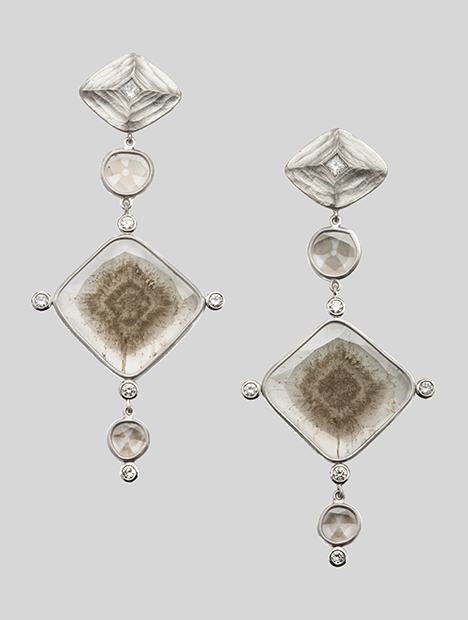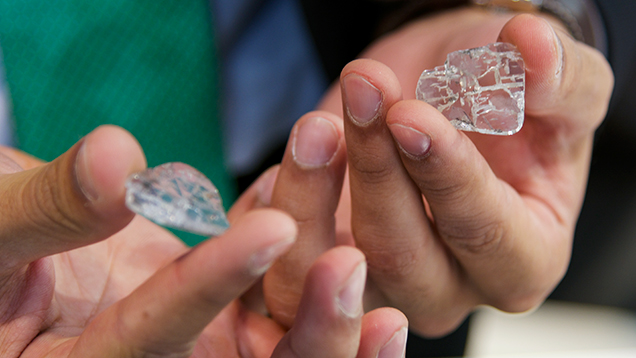Diamond Slices

Gem and mineral slices were very popular at this year’s Tucson shows, with opaque, translucent, clear, included, rough-edged, and finely shaped slices found in every color and price point. Materials such as fossilized coral, rutilated quartz, lacy agates, labradorite, chalcedony, watermelon tourmaline, sapphire, and diamond were on display. A wide variety of sizes were available as well, with pieces measuring several centimeters in diameter finding their way into dramatic necklaces, while some high-end jewelry and collector pieces used extremely thin and small gem slices.
Notably, the third-place winner in the bridal category of the 2015 AGTA Spectrum Awards was a pair of platinum and diamond earrings designed by Michael Endlich, featuring three pairs of diamond slices in addition to several pavé-set diamonds (figure 1). Endlich finds this gem material unusual, exciting, and subtle. Most of his clients have never seen these slices and are fascinated once they realize they are looking at diamonds. He goes through thousands of slices to select those he will incorporate into pieces. He particularly likes slices with patterns, such as concentric squares. This material is relatively new to the marketplace, and he first came upon it six years ago. Even though more diamond dealers offer them today, few slices have the distinct patterns Endlich looks for.
At the GJX show, Punya Malpani (Dynamic International, Hong Kong) discussed the diamond slice market with us and shared some particularly eye-catching and rare examples. He noted that the price of these goods has gone up approximately 20× in the past decade, as jewelry designers continue to go beyond traditional faceted gem shapes. There is also a strong collectors’ market for this material, as the unique nature of each piece adds to its appeal. In fact, there are very few larger slices of diamond in the marketplace, because the outer “skin” from the rough material was generally discarded before this niche market was identified. Unlike faceted diamonds, inclusions increase the value of slices, especially if they are unusual, striking, and highlight growth patterns.
Diamond slices today are mainly cut by laser and can vary widely in diameter and thickness, though diameters greater than one centimeter are difficult to come by, as rough in that size is much rarer. Many slices are slightly faceted to add some sparkle to the finished piece. Most of the diamond slices maintain the rough outline, as this can add to the appeal, but some are shaped into fanciful and matched sizes such as the “snowflakes” Malpani showed us.
Three-rayed “trapiche” diamond slices are among the most scarce and striking, as they contain a recognizable radiation-symbol pattern (figure 2). These are only found about once in a couple of thousand slices, and even then it is rare to find distinct coloring. The collection shown in the photo took years to assemble.


It appears that the use of gem slices in jewelry has penetrated the high-end market. Since diamond is clearly a prominent material capitalizing on this gem “cut” with natural appeal, we can expect this trend to continue.



